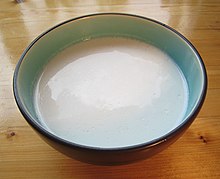Plant milk
 | |
| Type | Non-dairy beverage |
|---|---|
| Color | White |
| Flavor | Creamy |
| Ingredients | Based on a grain, pseudocereal, legume, nut, seed, or coconut |


Plant milk, also known as non-dairy milk, with the subcategory nut milk, has been consumed for centuries in various cultures, both as a regular drink (e.g. Spanish horchata) and as a substitute for dairy milk. The most popular plant milks are soy milk, almond milk, rice milk and coconut milk. All plant milk contains no lactose or cholesterol, and is usually sold with added calcium and vitamins, especially B12, but the protein content varies.
There are several reasons for consuming plant milk: ethical reasons, such as animal welfare; environmental reasons; health reasons, including such conditions as lactose intolerance, milk allergy and phenylketonuria; dietary reasons, such as veganism and ovo-vegetarianism; religious reasons, such as by some Christian denominations during Lent; and simple taste preference.
In the United States, soy milk was long the most popular non-dairy milk, but, starting around 2010, almond milk began to increase in popularity, and in 2013 it surpassed soy milk as the most popular variety.[1] Other popular milks in the US are rice and coconut milks. In the U.S., plant-based milk is 9.3% of the total milk market.[2] In Europe, soy and oat milks are popular. There is also hemp milk, cashew milk, hazelnut milk, flax milk, and milk from peas and lupin.[3] The global dairy alternative market is set to be worth US$16.3 billion in 2018.[4]
Plant milks are also used to make ice cream, plant cream, vegan cheese and yogurt (e.g. soy yogurt).
Types
Common plant milks are almond milk, soy milk, coconut milk and rice milk. Other plant milks include hemp milk, peanut milk, pea milk and oat milk.
Plant milks can be made from:
- Grains: barley, oat, spelt, rice
- Pseudocereals: quinoa
- Legumes: soy, lupin, pea, peanut
- Nuts: almond, cashew, hazelnut, pistachio, walnut
- Seeds: chia seed, flaxseed, pumpkin seed, sesame seed, sunflower seed, hemp seed
- Other: coconut
A blend is a plant milk created by mixing two (usually) or more types together. Some examples of blends are almond-coconut milk and almond-cashew milk. Horchata, a Spanish rice milk sometimes containing almonds, is a specific example of a traditional plant milk. Amazake is a Japanese rice milk.
Nutritional comparison with milk
| Nutritional content of cow, soy, and almond milks | |||
|---|---|---|---|
| Cow milk (whole, vitamin D added)[5] |
Soy milk (unsweetened; calcium, vitamins A and D added)[6] |
Almond milk (unsweetened)[7] | |
| Calories (cup, 243g) | 149 | 80 | 39 |
| Protein (g) | 7.69 | 6.95 | 1.55 |
| Fat (g) | 7.93 | 3.91 | 2.88 |
| Saturated fat (g) | 4.55 | 0.5 | 0 |
| Carbohydrate (g) | 11.71 | 4.23 | 1.52 |
| Fibre (g) | 0 | 1.2 | 0 |
| Sugars (g) | 12.32 | 1 | 0 |
| Calcium (mg) | 276 | 301 | 516 |
| Potassium (mg) | 322 | 292 | 176 |
| Sodium (mg) | 105 | 90 | 186 |
| Vitamin B12 (µg) | 1.10 | 2.70 | 0 |
| Vitamin A (IU) | 395 | 503 | 372 |
| Vitamin D (IU) | 124 | 119 | 110 |
| Cholesterol (mg) | 24 | 0 | 0 |
See also
- Health food
- Plant cream
- Roasted grain beverage
- Sikhye, a sweet, low-alcoholic Korean drink
- Vegan cheese
References
- ^ Wong, Venessa (August 21, 2013). "Soy Milk Fades as Americans Opt for Drinkable Almonds". BusinessWeek.
{{cite web}}: Italic or bold markup not allowed in:|publisher=(help) - ^ Purdy, Chase (20 December 2017). "A tech startup is making convincing cow-free milk by genetically engineering yeast". Quartz. Retrieved 20 December 2017.
- ^ Epperly, Victoria. Daniel's Lifestyle Fasting Cook Book. Xulon Press, 2008, pp. 248–250.
- ^ "Global Plant Milk Market to Top US $16 Billion in 2018: Dairy Alternative Drinks Are Booming, Says Innova Market Insights". 13 June 2017. Retrieved 13 April 2018.
- ^ "Milk, whole, 3.25% milkfat, with added vitamin D", United States Department of Agriculture, Agricultural Research Service.
- ^ "Soymilk (all flavors), unsweetened, with added calcium, vitamins A and D", United States Department of Agriculture, Agricultural Research Service.
- ^ "Beverages, almond milk, unsweetened, shelf stable", United States Department of Agriculture, Agricultural Research Service.
External links
- Wikibooks Cookbook category for Nut and Grain Milk recipes

